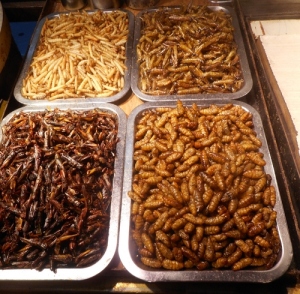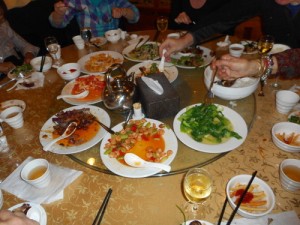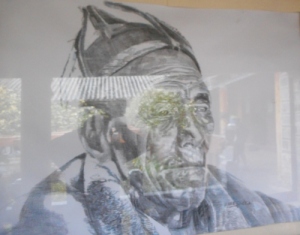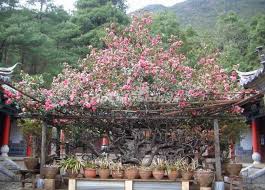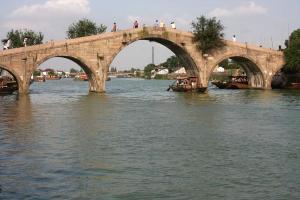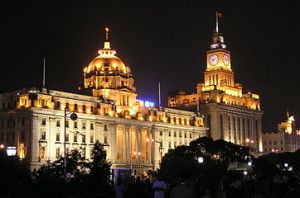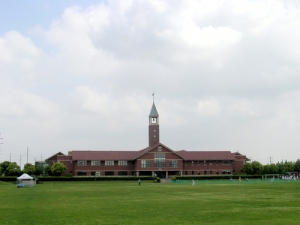Insectarians would find Lijiang a treat. How about some fried cockroaches and maggots for a snack?
Unfortunately we never acquired a taste for these members of the animal kingdom and stuck to a mixture of European and Chinese breakfast which includes delicious dumplings and a lot of soup. One thing is certain we were never spoilt for choice in our cuisine and discovered how truly limited many so-called Chinese restaurants in the west are.
Here were our first views on stepping outside our hotel in Lijiang. First, however, we joined a trip to explore the surrounding country around a town first made famous last century by those mythical travellers, British Bruce Chatwin. Russian Peter Goullart and American Joseph Rock.
Some roadside sights were very familiar to anyone who has lived in our part of the Lucchesia for some time.
We headed for a remote temple which has the oldest Camelia tree in the world.
As you’ll know tea is a species of camellia. We love the camellia festival in the Compitese area of the Pisan hills and regularly attend it. (For more on that see my posts at https://longoio2.wordpress.com/2016/03/20/the-ravishing-camellias-of-compitese/ and https://longoio2.wordpress.com/2015/03/30/la-traviatas-favourite-flower/ and https://longoio.wordpress.com/2013/04/24/one-hundred-roman-farms-and-one-thousand-camellias/ and https://longoio.wordpress.com/2013/04/01/thankyou-camellia/ .
We’ve even inherited our own camellia tree when we bought our little house in 2005. We were thus very keen to visit the ancient lamasery of Yufeng. We were now in a border country where Confucianism, animism, and both Chinese and Tibetan Buddhism coexist. Indeed, the ethnic minorities of this area count well over twenty different groups. The Yufeng lamasery belongs to the Scarlet sect (as distinct from the yellow hat – more of that when we enter Tibet) and dates back to 1756 (the year of Mozart’s birth…) during the reign of Emperor Qianlong (Qing dynasty).
We were welcomed by a chorus of Nakhi grandmothers:
It’s a miracle that this temple, like so many others we visited in the orient, has survived one of the three great misdirected vicissitudes (yes, today the Chinese government recognizes the fact that they were indeed misdirected…) namely the great famine, the great leap forwards and the Cultural Revolution.
It was thanks to a wonderful Nakhi man, Nadu Lama that the ancient camellia tree was saved from the destructive forces of the country’s equivalent of what’s still happening to the cultural heritage of Syria and Iraq. Sadly, we were too late to meet Nadu as he died last year but we regard him as one of the great unsung heroes of modern-day China.
My knowledge of architectural styles in this part of the world is sorely lacking but I gather Yufeng temple is an amalgam of Han (majority Chinese), Tibetan, Taoist and the local Nakhi (or Naxi) Dingba animist religion.
Unfortunately, we arrived at the wrong time of year to enjoy the wonderful blossoms of the camellia which are best appreciated in the spring and early summer.
The intimate atmosphere, the incredible convolutions of the camellia and the wonderful views, however, more than compensated for that and we did see a photograph of a blossoming shrub which has changed not only Chinese drinking habits but that of so many other countries including, of course, our own UK and has extended well into politics as well.
The camellia itself was planted by Emperor Chenghua of the Ming dynasty over five hundred years ago. It’s thus rather older than the temple itself. The flowers bloom for around a hundred days and the tree has over twenty thousand (!) blossoms). Incredibly, it’s two camellias in one: the pink camellia and the white. They seem to have bonded together like passionate lovers.
No wonder Nadu Lama devoted his entire life to protecting this one plant. Would you risk your life to protect one of earth’s natural glories in such a devoted fashion?
The whole area is indescribably beautiful but be warned, after recent rains, the temple steps (each temple must have its, usually steep, steps as it’s built on a hill, and you have to pay a little penance to get to its holy of holies) can get a little slippery!
PS In case your knowledge of Chinese dynasties is slim (as is mine) here is a chart to help you along when I describe later episodes in our eastern odyssey:
| Dynasty | Rulers | Ruling house or clan of houses | From | To | Length | |||
| Name | Chinese | Meaning | ||||||
| Confederacy dynasties | ||||||||
| Xia dynasty | 夏 | Xià | Tribe name | (list) | Sì (姒) | 2070 BC | 1600 BC | 470 years |
| Shang dynasty | 商 | Shāng | Toponym | (list) | Zǐ (子) | 1600 BC | 1046 BC | 554 years |
| Western Zhou dynasty | 西周 | Xī Zhōu | Toponym | (list) | Jī (姬) | 1046 BC | 771 BC | 275 years |
| Eastern Zhou dynasty | 東周 / 东周 | Dōng Zhōu | Toponym | (list) | Jī (姬) | 770 BC | 256 BC | 515 years |
| Spring and Autumn period | 春秋 | Chūn Qiū | As English | 770 BC | 476 BC | 295 years | ||
| Warring States period | 戰國 / 战国 | Zhàn Guó | As English | 476 BC | 221 BC | 255 years | ||
| Imperial dynasties | ||||||||
| Qin dynasty | 秦 | Qín | Toponym | (list) | Yíng (嬴) | 221 BC | 206 BC | 15 years |
| Western Han dynasty | 西漢 / 西汉 | Xī Hàn | Toponym | (list) | Liú (劉) | 206 BC or 202 BC | 9 AD | 215 years |
| Xin dynasty | 新 | Xīn | “New” | (list) | Wáng (王) | 9 AD | 23 AD | 14 years |
| Eastern Han dynasty | 東漢 / 东汉 | Dōng Hàn | Toponym | (list) | Liú (劉) | 25 AD | 220 AD | 195 years |
| Three Kingdoms | 三國 / 三国 | Sān Guó | As English | (list) | Cáo (曹) Liú (劉 / 刘) Sūn (孫 / 孙) |
220 AD | 280 AD | 60 years |
| Western Jin dynasty | 西晉 / 西晋 | Xī Jìn | Toponym | (list) | Sīmǎ (司馬) | 265 AD | 317 AD | 52 years |
| Eastern Jin dynasty | 東晉 / 东晋 | Dōng Jìn | Toponym | (list) | Sīmǎ (司馬) | 317 AD | 420 AD | 103 years |
| Southern and Northern dynasties | 南北朝 | Nán Běi Cháo | As English | (list) | various | 420 AD | 589 AD | 169 years |
| Sui dynasty | 隋 | Suí | Ducal title (随 homophone) |
(list) | Yáng (楊) | 581 AD | 618 AD | 37 years |
| Tang dynasty | 唐 | Táng | Ducal title | (list) | Lǐ (李) | 618 AD | 907 AD | 289 years |
| Five Dynasties and Ten Kingdoms | 五代十國
/ 五代十国 |
Wǔ Dài Shí Guó | As English | (list) | various | 907 AD | 960 AD | 53 years |
| Kingdom of Dali | 大理國
/ 大理国 |
Dà Lǐ Guó | Toponym | (list) | Duan (段) | 937 AD | 1253 AD | 316 years |
| Northern Song dynasty | 北宋 | Běi Sòng | Toponym | (list) | Zhào (趙) | 960 AD | 1127 AD | 167 years |
| Southern Song dynasty | 南宋 | Nán Sòng | Toponym | (list) | Zhào (趙) | 1127 AD | 1279 AD | 152 years |
| Liao dynasty | 遼 / 辽 | Liáo | “Vast” or “Iron” (Khitan homophone) |
(list) | Yelü (; 耶律) | 907 AD or 916 AD | 1125 AD | 209 years |
| Jin dynasty | 金 | Jīn | “Gold” | (list) | Wanggiya (; 完顏) |
1115 AD | 1234 AD | 119 years |
| Western Xia | 西夏 | Xī Xià | Toponym | (list) | Li (𘝾; 李) | 1038 AD | 1227 AD | 189 years |
| Western Liao | 西遼 | Xī Liáo | “Vast” or “Iron” (Khitan homophone) |
(list) | Yelü (; 耶律) | 1124 AD | 1218 AD | 94 years |
| Yuan dynasty | 元 | Yuán | “Great” or “Primacy” | (list) | Borjigin (ᠪᠣᠷᠵᠢᠭᠢᠨ; 孛兒只斤) |
1271 AD | 1368 AD | 97 years |
| Ming dynasty | 明 | Míng | “Bright” | (list) | Zhū (朱) | 1368 AD | 1644 AD or 1662 AD | 276 years |
| Qing dynasty | 清 | Qīng | “Pure” | (list) | Aisin Gioro ( ᠠᡳᠰᡳᠨ ᡤᡳᠣᡵᠣ; 愛新覺羅) |
1636 AD or 1644 AD | 1912 AD | 268 years |
PPS Don’t worry if you can’t place them as easily as such terms as ‘mediaeval,’, ‘renaissance’, ‘rococo, or even ‘baroque’. The most important dynasties to remember are clearly the last two: the Ming and Qing.

